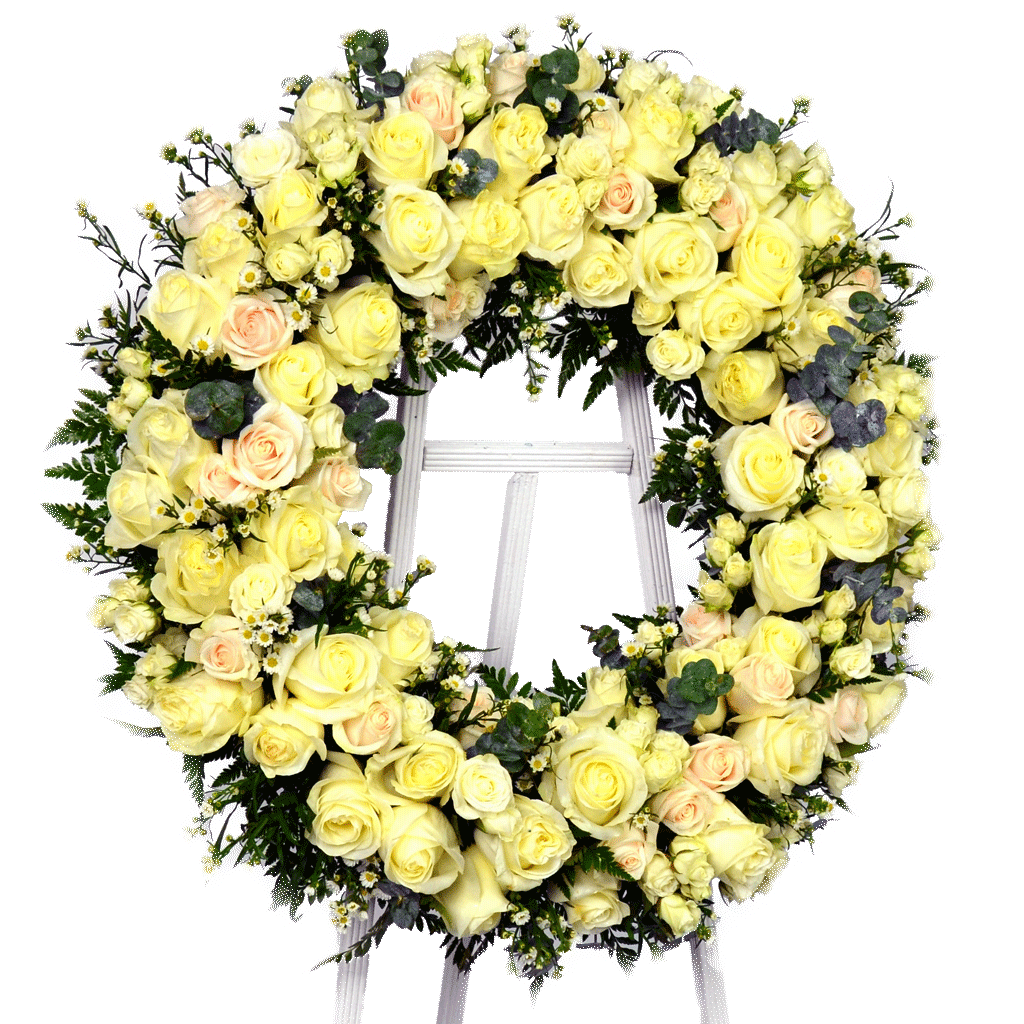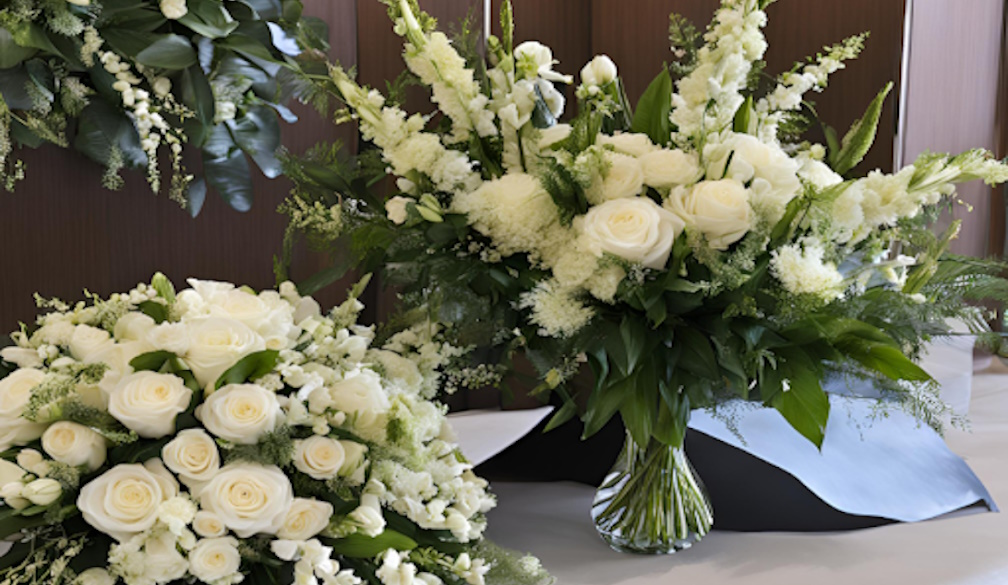The Enduring Symbolism of the Funeral Wreath: A Circle of Remembrance

The funeral wreath, a familiar sight at memorial services and gravesides, is far more than just a floral arrangement. It is a deeply symbolic object, imbued with history, tradition, and profound meaning. Its circular form, evergreen materials, and carefully chosen flowers all contribute to a powerful expression of grief, remembrance, and enduring love. This article delves into the rich history, symbolism, and contemporary usage of the funeral wreath, exploring its evolution and enduring significance in our rituals of mourning.
A History Rooted in Eternity:
The origins of the funeral wreath can be traced back to ancient civilizations. In ancient Greece and Rome, wreaths were often made of laurel, ivy, or oak leaves and presented to victors in athletic competitions and military campaigns. These wreaths symbolized triumph, honor, and immortality. The circular shape, representing eternity and the cyclical nature of life, was already a prominent feature.
Over time, the association with triumph shifted to encompass the victory over death. Early Christians adopted the wreath, incorporating it into their funeral rituals. The evergreen materials, such as pine, fir, and holly, represented eternal life and the unwavering faith in resurrection. The circle, unbroken and continuous, became a powerful symbol of the soul’s journey beyond the earthly realm.
During the Middle Ages, funeral wreaths gained further prominence, often displayed on coffins and tombs. The flowers used were carefully chosen for their symbolic meanings, adding layers of depth to the expression of grief. Roses, lilies, and carnations became popular choices, each carrying its own specific message of love, purity, and remembrance.
By the Victorian era, funeral wreaths reached their peak of elaborate design and symbolic complexity. The Victorians, known for their elaborate mourning rituals, used wreaths extensively to express their grief and commemorate the deceased. Wreaths were often made of dried flowers, feathers, and even human hair, each element carefully selected to convey a specific message. The size and extravagance of the wreath often reflected the social status and wealth of the bereaved family.
The Language of Flowers: Symbolic Meanings within the Wreath:
The selection of flowers for a funeral wreath is rarely arbitrary. Each bloom carries a specific symbolic weight, adding a deeper layer of meaning to the overall expression of grief and remembrance. Understanding this "language of flowers," or floriography, can provide a more nuanced appreciation of the wreath’s significance.

Roses: Red roses symbolize love, respect, and courage. White roses represent purity, innocence, and reverence. Pink roses express gratitude and appreciation. Yellow roses, while sometimes associated with friendship, can also signify remembrance and caring.
Lilies: White lilies are a classic choice for funeral wreaths, symbolizing purity, innocence, and the soul’s return to peace. They are often associated with resurrection and the promise of eternal life.
Carnations: Red carnations express love and affection, while white carnations symbolize innocence and pure love. Pink carnations represent remembrance and gratitude.
Chrysanthemums: In some cultures, particularly in Asia, chrysanthemums are strongly associated with mourning and are a common choice for funeral arrangements. White chrysanthemums symbolize grief and sorrow.

Gladioli: These tall, stately flowers represent strength of character, integrity, and sincerity. They are often used to honor someone who lived a virtuous and upright life.
Forget-Me-Nots: As their name suggests, these delicate blue flowers symbolize remembrance and enduring love. They are a poignant reminder to never forget the deceased.
Ivy: Ivy represents fidelity, immortality, and everlasting life. Its clinging nature symbolizes the enduring bond between the living and the deceased.
Evergreen Branches: Pine, fir, and holly branches symbolize eternal life, hope, and the unwavering faith in resurrection. Their vibrant green color provides a comforting contrast to the somber atmosphere of mourning.
The Circular Form: A Symbol of Eternity and Continuity:
The circular shape of the funeral wreath is perhaps its most fundamental and enduring symbol. The circle, without beginning or end, represents eternity, the cyclical nature of life, and the unbroken bond between the living and the deceased. It signifies the soul’s journey beyond the earthly realm and the hope of eternal life.
The circular form also represents unity and wholeness. It symbolizes the coming together of family and friends to support one another during a time of grief. The wreath, placed on a coffin or grave, serves as a visual reminder of the enduring love and connection that remains even after death.
Contemporary Usage and Modern Interpretations:
While the traditional symbolism of the funeral wreath remains strong, contemporary usage allows for greater personalization and individual expression. Modern wreaths often incorporate a wider variety of flowers, colors, and materials, reflecting the unique personality and life of the deceased.
Personalized Wreaths: Bereaved families may choose to incorporate flowers that were particularly loved by the deceased, or that reflect their hobbies, interests, or profession. For example, a wreath for a gardener might include sunflowers, daisies, and other wildflowers.
Themed Wreaths: Some families opt for themed wreaths that reflect the deceased’s passion for a particular sport, hobby, or cause. This can be a meaningful way to celebrate their life and legacy.
Sustainable Wreaths: With increasing awareness of environmental concerns, sustainable funeral wreaths are becoming more popular. These wreaths are made using locally sourced, biodegradable materials, minimizing their environmental impact.
Alternative Materials: While flowers remain the most common material, wreaths can also be made of other materials, such as leaves, branches, berries, and even recycled materials.
Beyond the Funeral: Wreaths as Memorials:
The symbolism of the wreath extends beyond the funeral service. Wreaths are often placed on gravesites, war memorials, and other places of remembrance to honor the deceased and commemorate their lives. They serve as a tangible expression of enduring love, respect, and gratitude.
The Enduring Power of Symbolism:
The funeral wreath, with its rich history, symbolic meanings, and enduring form, remains a powerful and poignant expression of grief, remembrance, and enduring love. Its circular shape, evergreen materials, and carefully chosen flowers all contribute to a profound message of hope, comfort, and the promise of eternal life. As we continue to evolve our rituals of mourning, the funeral wreath will undoubtedly remain a central symbol of remembrance and a testament to the enduring power of symbolism in our lives.
FAQ: Funeral Wreaths
Q: What is the significance of a funeral wreath?
A: A funeral wreath is a floral arrangement shaped in a circle, symbolizing eternity, the cyclical nature of life, and enduring love. It is used to express grief, remembrance, and respect for the deceased.
Q: What flowers are commonly used in funeral wreaths and what do they symbolize?
A: Common flowers include roses (love, respect), lilies (purity, innocence), carnations (love, remembrance), chrysanthemums (grief), gladioli (strength of character), and forget-me-nots (remembrance).
Q: Why is the wreath shaped like a circle?
A: The circular shape represents eternity, the unbroken bond between the living and the deceased, and the cyclical nature of life. It symbolizes the soul’s journey beyond the earthly realm and the hope of eternal life.
Q: Can I personalize a funeral wreath?
A: Yes, contemporary wreaths allow for personalization. You can incorporate flowers that were loved by the deceased, reflect their hobbies, or choose a themed wreath.
Q: Where are funeral wreaths typically placed?
A: They are typically placed on coffins, gravesites, memorial services, and other places of remembrance.
Q: What are sustainable funeral wreaths?
A: Sustainable wreaths are made using locally sourced, biodegradable materials, minimizing their environmental impact.
Q: Is it appropriate to send a funeral wreath to the family’s home?
A: Generally, wreaths are more appropriate for the funeral service itself. Sending flowers or a plant to the family’s home is often a more suitable gesture of sympathy.
Q: How much does a funeral wreath typically cost?
A: The cost can vary widely depending on the size, materials, and complexity of the design. Prices can range from $100 to several hundred dollars.
Q: Where can I purchase a funeral wreath?
A: You can purchase them from local florists, online flower delivery services, and some funeral homes.
Q: Are there alternatives to traditional flower wreaths?
A: Yes, wreaths can be made of other materials such as leaves, branches, berries, and even recycled materials.
Conclusion: A Timeless Expression of Love and Remembrance
The funeral wreath, a timeless symbol of remembrance and enduring love, continues to hold a significant place in our rituals of mourning. From its ancient origins to its contemporary interpretations, the wreath’s circular form, evergreen materials, and carefully chosen flowers convey a profound message of hope, comfort, and the promise of eternal life. As we navigate the complexities of grief and loss, the funeral wreath serves as a tangible expression of our enduring connection to those who have passed, a testament to the enduring power of symbolism, and a reminder that love transcends the boundaries of life and death. Its presence at memorial services and gravesites provides solace, honors the deceased, and strengthens the bonds of community in times of sorrow. The funeral wreath, in its silent eloquence, continues to speak volumes about the enduring power of love and remembrance.


